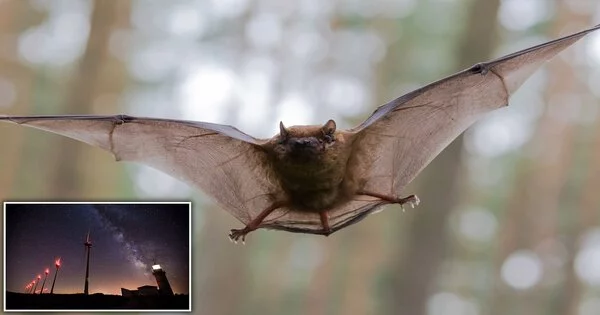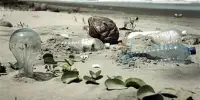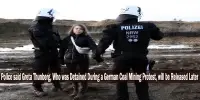The numerous deaths of bats at wind turbines (WT) have a negative impact on the populations of affected species and may have far-reaching implications for biodiversity in rural areas. Until now, it could only be assumed that bat deaths had additional consequences. In a paper published in the scientific journal Conservation Science and Practice, a team of scientists from the Leibniz Institute for Zoo and Wildlife Research (Leibniz-IZW) show that natural food chains are disrupted, which can have far-reaching negative consequences for agriculture and forestry. The study demonstrates how much the functional importance of bats for habitats has previously been underestimated.
The scientists at the Leibniz-IZW investigated the prey spectrum of the common noctule (Nyctalus noctula), a common bat species that frequently dies at wind turbines in Germany. By focusing on the insects consumed by the bats, they documented the extent to which their functional importance for habitats is lost.
Carolin Scholz and Christian Voigt of the Leibniz-IZW investigated which insects consumed common noctules shortly before dying at wind turbines. They did this by analyzing the stomach contents of 17 common noctules killed by wind turbines. The scientists used PCR amplification and high-throughput sequencing to look for the genetic barcodes of the insects eaten by bats. These genetic barcodes provide information about the consumed species’ identity. “We discovered DNA barcodes of 46 insect species from nine orders, the majority of which were beetles and moths,” says Scholz, the study’s first author.
We do not know what the current intensification of land use will mean for biodiversity and the resilience of these habitats. This is especially unfortunate because this transformation is currently taking place on a large scale in our landscapes.
Christian Voigt
“The insect species could be assigned to a wide range of habitats, including farmland and grassland, as well as forests and wetlands.” In agriculture and forestry, 20% of the identified insect species are considered pests or nuisances, such as the chestnut weevil (Curculio elephas) and the chestnut fruit moth (Cydia splendana). The scientists conclude that the extinction of bats disrupts existing food chains, potentially leading to an increase in the number of pests and nuisance species, which could be offset by chemical pest control. Wind turbines reduce the free ecosystem service of pest reduction by bats, resulting in an emerging problem for agriculture and forestry.
Wind energy production undeniably helps to reduce CO2 emissions. Finally, the amount of space required for this is substantial, and the ecological consequences for affected animal groups such as bats and insects are significant. It was recently decided in Germany to double the land area used for wind energy production, focusing on agricultural land and forest monocultures.

These ecosystems already have low biodiversity, as they have undergone several waves of intensification over the centuries, with farmland cleared and cultivation methods optimized for increased harvest. The WTs that are now being installed in Germany as part of the energy transition drive a new wave of intensification.
“We do not know what the current intensification of land use will mean for biodiversity and the resilience of these habitats. This is especially unfortunate because this transformation is currently taking place on a large scale in our landscapes” According to Voigt, Head of the Department of Evolutionary Ecology.
“We still need to learn more about how the energy transition affects biological diversity in these habitats. There is no doubt that the installed wind turbines contribute to the protection of the global climate and thus to the conservation of biodiversity.” On the other hand, it is well known that a large number of bats are killed by wind turbines. “Because the affected species have low reproduction rates, the loss of these individuals is frequently difficult for the populations to buffer. Unfortunately, not only do individuals vanish from the landscape, but their interactions in complex food webs are also lost” Scholz says.
Counts show that each conventionally operated wind turbine kills more than ten bats per year. This equates to a six-digit number of annual bat fatalities at Germany’s 30,000 wind turbines on the mainland. During periods of high bat activity, newly installed turbines are temporarily shut down to prevent bats from colliding with the rotor blades. This reduces annual bat mortality to one or two individuals and WT. Unfortunately, old WTs continue to operate without such shutdown rules, accounting for 75 percent of all WTs in Germany.
“We have to reckon with more than 200,000 bats per year dying at WTs,” says Voigt. “If we continue to tolerate this high number of victims at WTs, fewer and fewer insect pests will be consumed by bats,” he concludes. As predators, bats play an important role in the natural regulation of insect populations. The loss of bats and their role in food chains makes ecosystems more vulnerable to disturbances, Voigt and Scholz speculate. More in-depth scientific work is needed to understand the food-web links and the consequences of their disruption more precisely.
An important first step toward bat conservation and their functional role in their habitats must be the mandatory shutdown of wind turbines during periods of high bat activity, according to Voigt and Scholz. To that end, the approval process for old wind turbines must be reconsidered. This is the only way to keep the negative effects of intensified land use caused by the energy transition on our ecosystems to a minimum.
















